In 1957, police entered Ed Gein's home in Plainfield, Wisconsin, to find a missing woman. They not only found her decapitated body, but also chairs, lampshades, and wastebaskets made of human skin.
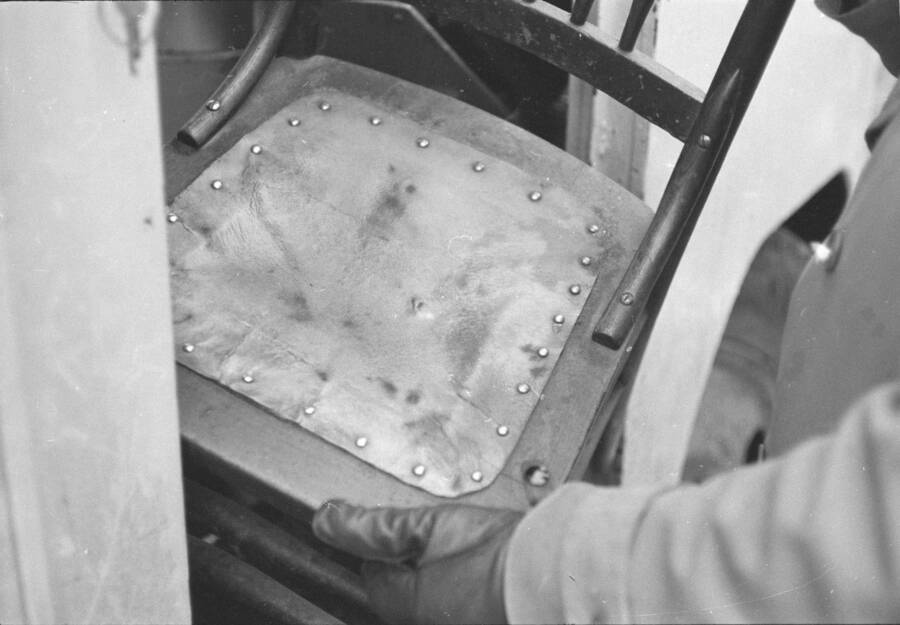
Bettmann/Getty ImagesDetectives removing a chair upholstered with human skin from Ed Gein’s home.
In a run-down yet otherwise nondescript farmhouse in Plainfield, Wisconsin, a macabre and gruesome collection was coming together. Ed Gein, who came to be known as the “Butcher of Plainfield,” had always been reclusive, but unbeknownst to other Plainfield residents, he had a morbid fascination: making furniture out of human skin and other body parts.
After his mother’s death in 1945, something in Gein snapped. He boarded up the rooms she’d used and turned their home into a chilling shrine to her memory, all the while slipping further into his ghoulish obsessions. He spent his days reading about Nazi medical experiments, studying human anatomy, reading horror novels, and consuming porn. Eventually, twisted fantasies formed in his mind — fantasies he would soon act upon.
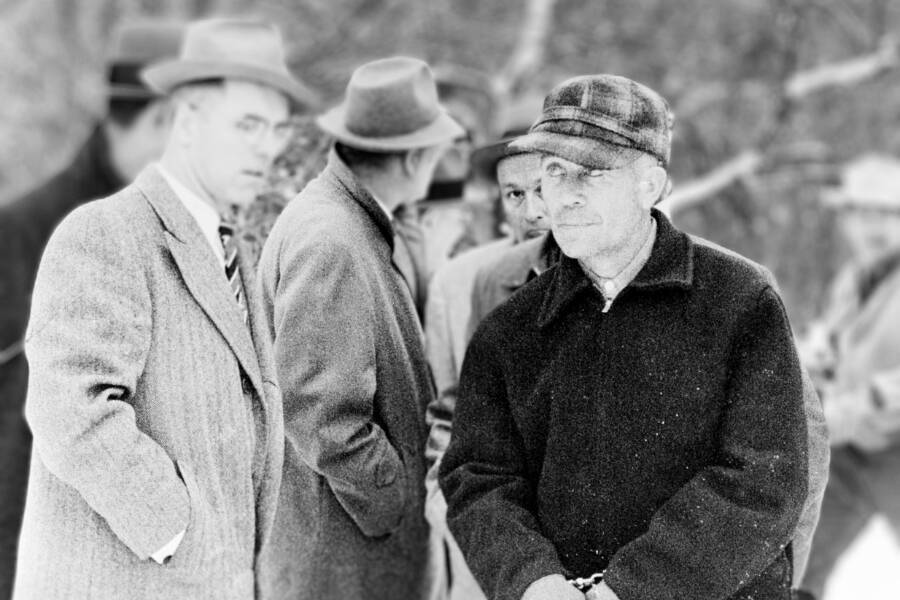
Bettmann/Getty ImagesEd Gein leading investigators around his property, which was full of macabre furniture and clothing.
More than a decade later, in November 1957, a local hardware store owner named Bernice Worden disappeared. Her last customer just so happened to be Ed Gein. Police decided to pay him a visit, but nothing could prepare them for the house of horrors that they were about to enter.
They did indeed find Bernice Worden at Gein’s farmhouse, decapitated and hanging by her ankles from the rafters, but this was just one horrifying discovery. Throughout the house were various human body parts and pieces of Ed Gein’s furniture — which he crafted with human skin and bones.
Ed Gein’s Furniture Inside His House Of Horrors
Ed Gein’s gruesome home had been a secret to the outside world for years, but after officers entered, that secret became sensational news.
The macabre items inside, many of which were decorated with human skin and skulls, would later help inspire famous horror movies, including The Texas Chainsaw Massacre, The Silence of the Lambs, and Psycho.
During the search of Ed Gein’s house, police found various organs in jars and skulls turned into soup bowls. They also found household items that were created by Gein himself, after he carefully skinned human corpses.

Frank Scherschel/The LIFE Picture Collection/Getty ImagesEd Gein lived in mostly appalling conditions. However, he kept his mother’s rooms clean and spotless.
These included chairs upholstered with human skin, a wastebasket made of skin, and a lampshade made from a face. There was also a pair of lips being used as a window shade drawstring, and skulls decorating bedposts.
Chillingly, Gein had also created numerous horrific items of clothing, including a belt made out of human nipples, a corset made of a female torso, leggings made of leg skin, and masks made from faces.
Though he only admitted to murdering two women — Worden and tavern keeper Mary Hogan (whose remains were also found in the house) — authorities found human remains from many more bodies in his home.
Most of these remains came from local graveyards, which Gein frequently visited to rob, not for their valuables, but for the bodies themselves. He started by digging up his dead mother’s grave and desecrating her corpse by twisting her head from her body. Then, he began keeping track of obituaries, looking for other women who resembled his mother.
Whenever he learned about a deceased woman who looked similar to his mom, Ed Gein would find out where she was buried, visit that graveyard at night, and steal the corpse’s body parts to create new furniture or clothing pieces. He claimed that these body parts were insufficient for all the items he wanted to design, leading him to murder two women (though he’s often suspected of killing more). Obviously, something in Gein’s psychology was twisted, but the question of why he went down this path still remained.
Authorities learned part of the answer when Gein confessed to a particularly disturbing ambition: He wanted to create a “woman suit” inspired by his mother, so he could “become” his mom and crawl into her skin.
The Butcher Of Plainfield’s Twisted Love For His Deceased Mother
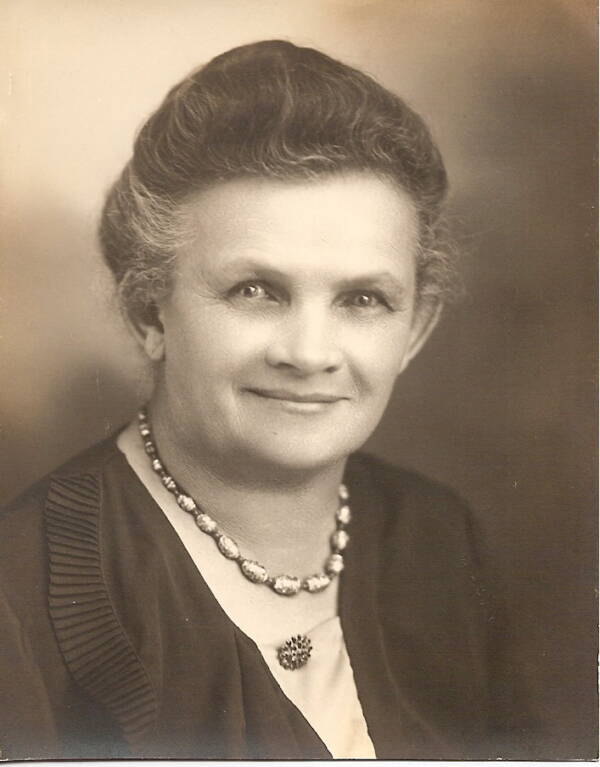
Find a GraveAugusta Wilhelmine Gein, Ed Gein’s mother.
Augusta Wilhelmine Gein had always kept her sons isolated. Ed and his brother, Henry, were subjected to Augusta’s religious fanaticism and puritanical teachings early on. Augusta frequently warned them that pursuing women and sex would lead them down a path of immorality.
Outside of school, where Ed was often bullied, the Gein boys were not allowed to socialize, and they spent much of their time on the farm.
Forensic psychiatrist Carole Lieberman told A&E that this isolation likely led to Ed Gein eventually developing an Oedipus complex, and that he probably had “a sexual, romantic attraction to his mother.”
“The fact that she hated her husband made her more reliant on her sons for companionship,” Lieberman added. “So, there was a part of her that was nurturing this dependency on her sons.”

Bettmann/Getty ImagesA photo of Ed Gein’s kitchen, where some of his macabre household items and furniture were found.
Ed Gein’s obsession with his mother also fueled some speculation that he may have been responsible for his own brother Henry’s death.
The two Gein brothers had been burning brush on the family farm when Henry suddenly died, apparently because of an uncontrollable fire. Coroners ruled that he had died of asphyxiation from inhaling smoke, but strangely, bruising on his head was consistent with him being struck. It’s possible, though unconfirmed, that Ed may have attacked Henry in the field that day.
Whether Ed contributed to Henry’s death or not, he now had his mother all to himself. Notably, around this same time, Ed Gein began to read books about topics like grave robbing and human anatomy — perhaps setting the stage for his later creation of macabre furniture and clothing.
Meanwhile, Augusta’s health was severely declining. She had a stroke around the time of Henry’s death, which made her even more reliant on Ed. A second stroke in December 1945, however, claimed her life.
Ed, now entirely alone, apparently descended into madness.
The Psychology Of Ed Gein And The Mystery Of Why He Created Macabre Furniture And Clothing
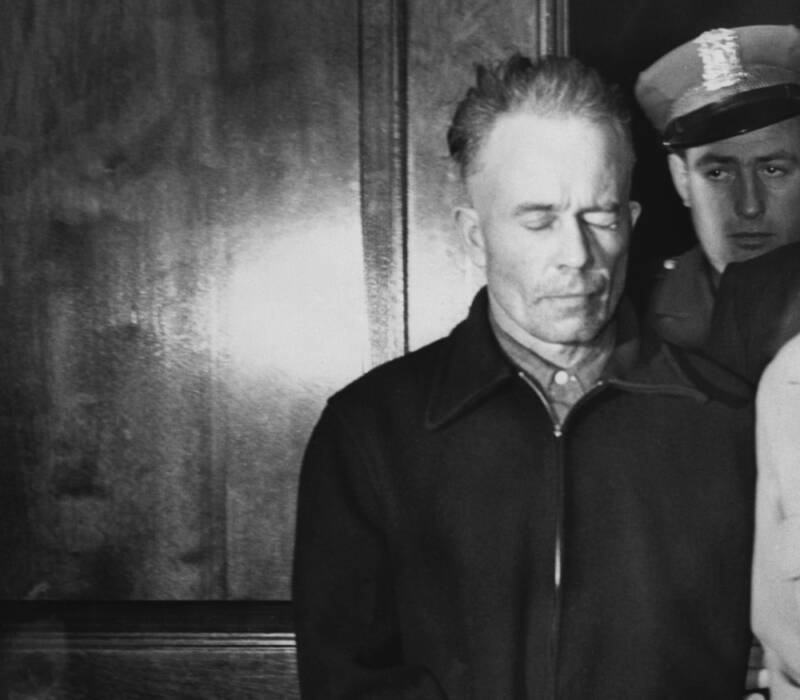
Bettmann/Getty ImagesEd Gein in court during his trial. He was found to be insane and was committed to a hospital for life.
Grief can manifest differently in anybody, but few people would respond to a loss like Ed Gein. And isolation alone wouldn’t drive most people to murder women and rob graves so they could mutilate corpses, decorate household items with human body parts, and create a “woman suit.”
Several psychiatrists examined him. But as psychology professor Louis Schlesinger told A&E, psychiatrists in the 1950s didn’t have the tools or experience to handle someone like Ed Gein, who created furniture and clothing with human remains and kept severed body parts in his home.
“In the 1950s, these were very extraordinary crimes and were not on anybody’s radar when they happened,” Schlesinger said. “In Gein’s case, he was probably dealing with several very disturbed psychopathologies.”
Officially, Gein was diagnosed with schizophrenia. Former classmates described behavior consistent with the diagnosis — such as randomly laughing for no reason — but in the decades since his case first made headlines, psychologists and online true crime aficionados have attempted to attribute other diagnoses to Gein. Others have tried to push a different narrative entirely, especially given the many horror characters Gein inspired.

Vortex Inc.Leatherface, The Texas Chainsaw Massacre killer inspired by Ed Gein.
As researcher Ryan Lee Cartwright explained in his book Peculiar Places, Gein inspired villains like Leatherface from The Texas Chainsaw Massacre, Buffalo Bill from The Silence of the Lambs, and Norman Bates from Psycho. Viewers sometimes associate these characters with a transgender identity, even though Hannibal Lecter specifically says Buffalo Bill is not transgender.
Still, some activists have expressed concern that these characters might reinforce the idea that transgender people are more likely to be dangerous. The horror characters may have also led to speculation that Gein was transgender as well, especially given his desire to make a “woman suit.” But it’s important to note that Gein’s suit was specifically connected to the idea of recreating and quasi-resurrecting his mother.
As Lieberman said, “He wanted to crawl into her skin.”
Many other myths have swirled around Ed Gein due to the characters he inspired, even though they have no basis in reality. Unlike Norman Bates, for instance, Ed Gein was far less charming and intelligent. There’s also no evidence that he engaged in cannibalism, despite common belief.
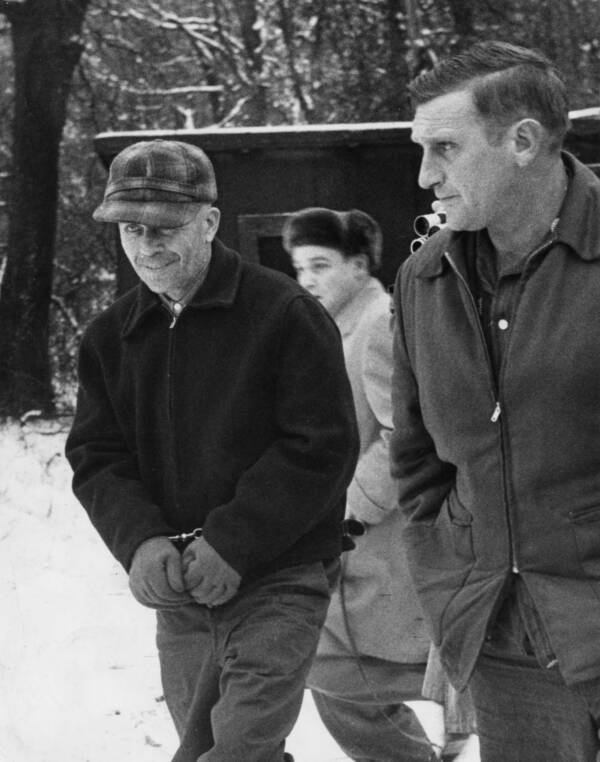
JOHN CROFT/Star Tribune via Getty ImagesEd Gein being led away in handcuffs.
So what exactly was wrong with Ed Gein — and why did he murder women, rob graves, and use human body parts to create furniture and clothing?
“Obviously, we all look at what he did and say [he] must have been sick to do what he did, but that’s not necessarily true,” said clinical associate professor of psychiatry Dr. Gail Saltz in an interview with A&E. “Psychodynamically, these murders were driven by his relationship with his mother, and by going after figures like her and destroying them, he would attempt to subsume them by taking their parts and making them part of him.”
It is difficult to know what was going on in Ed Gein’s head. Even the schizophrenia diagnosis is sometimes debated, and it’s unclear if Gein was a true psychopath, by definition, who lacked empathy and remorse. It’s certainly impossible to know his thoughts on gender identity.
After all, it wasn’t just the “woman suit” that Gein had been crafting in his home. Ed Gein’s furniture collection and household items, also made from various bits and pieces of the human body, represent a side of his dark passions that had nothing to do with “becoming” his mother.
What is clear is that he was capable of extreme cruelty, all while being completely broken from reality. It’s easy to see why some horror film writers used his story as inspiration when creating their most terrifying characters.
Next, read the disturbing story of serial killer Ted Bundy. Then, read about Jeffrey Dahmer and the cannibalistic crimes he committed.





